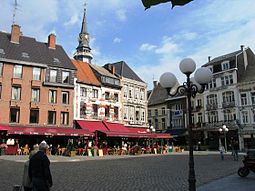
Back Limburg, België Afrikaans Provinz Limburg (Belgien) ALS Limburgo (Belchica) AN ليمبورغ (بلجيكا) Arabic ليمبورج , بلجيكا ARZ Limburg (Bélgia) BAN Лімбург (правінцыя, Бельгія) Byelorussian Лімбург (Бэльгія) BE-X-OLD Лимбург (Белгия) Bulgarian Limbourg (Belgia) Breton
Limburg | |
|---|---|
|
| |
| Anthem: "Limburg mijn Vaderland" "Limburg My Fatherland" | |
 | |
| Coordinates: 50°36′N 5°56′E / 50.600°N 5.933°E | |
| Country | |
| Region | |
| Capital (and largest city) | Hasselt |
| Government | |
| • Governor | Jos Lantmeeters |
| Area | |
• Total | 2,427 km2 (937 sq mi) |
| Population (1 January 2024 [2]) | |
• Total | 900,098 |
| • Density | 370/km2 (960/sq mi) |
| GDP | |
| • Total | €31.766 billion (2021) |
| ISO 3166 code | BE-VLI |
| HDI (2021) | 0.930[4] very high · 7th of 11 |
| Website | www |

Limburg (Dutch: Limburg, pronounced [ˈlɪmbʏr(ə)x] ⓘ; Limburgish: Limburg [ˈlɪm˦ˌbʏʀ˦əx] or Wes-Limburg [wæsˈlɪm˦ˌbʏʀ˦əx]; French: Limbourg, pronounced [lɛ̃buʁ] ⓘ), also known as Belgian Limburg, is a province in Belgium. It is the easternmost of the five Dutch-speaking provinces that together form the Region of Flanders, which is one of the three main political and cultural sub-divisions of modern-day Belgium. As of January 2024, Limburg had a population of 0.9 million.[5]
Limburg is located west of the Meuse (Dutch: Maas), which separates it from the similarly-named Dutch province of Limburg. To the south it shares a border with the French-speaking province of Liège, with which it also has historical ties. To the north and west are the old territories of the Duchy of Brabant. Today these are the Flemish provinces of Flemish Brabant and Antwerp to the west, and the Dutch province of North Brabant to the north. Historically Belgian Limburg is roughly equivalent to the Dutch-speaking part of the secular lordship of the medieval Prince-Bishopric of Liège, which was dominated by the County of Loon.
The province of Limburg has an area of 2,427 km2 (937 sq mi) which comprises three arrondissements (arrondissementen in Dutch) containing 44 municipalities. Among these municipalities are the current capital Hasselt, and other large towns including Sint-Truiden, Genk, and Tongeren. Tongeren is the only Roman city in the province, and regarded as the oldest city of Belgium.
The municipality of Voeren is geographically detached from Limburg and the rest of Flanders, with the Netherlands to the north and the Walloon province of Liège to the south. This municipality was established by the municipal reform of 1977, and on 1 January 2008, with its six villages, it had a total population of 4,207. Its total area is 50.63 km2 (19.55 sq mi).
- ^ "Be.STAT".
- ^ "Structuur van de bevolking | Statbel".
- ^ "EU regions by GDP, Eurostat". Retrieved 18 September 2023.
- ^ "Sub-national HDI – Area Database – Global Data Lab".
- ^ "Structuur van de bevolking | Statbel".

